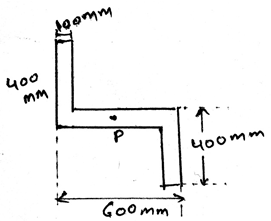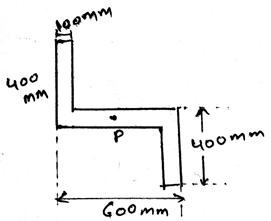This set of Engineering Mechanics Multiple Choice Questions & Answers (MCQs) focuses on “Moments of Inertia for an Area About Inclined Axis – 1”.
1. If the non-Uniform loading is of the type of parabola then for calculating the moment of inertia for areas inclined at an axis?
a) The net load will not be formed as all the forces will be cancelled
b) The net force will act the centre of the parabola
c) The net force will act on the base of the loading horizontally
d) The net force will act at the centroid of the parabola
View Answer
Explanation: The net force will act at the centroid of the parabola. Whether it be a parabola or the cubic curve the centroid is the only point at which the net force act. Force can’t be acted horizontally if the loading is vertical. Hence whatever be the shape of the loading, the centroid is the point of action of net force. Thus the use of centroid.
2. Determine the orientation of the principle axis for the cross section of area of member shown whose width is 100mm.
a) 57.1˚
b) 5.1˚
c) 7.1˚
d) 52.1˚
View Answer
Explanation: The net force will act at the centroid of the parabola. Whether it be a parabola or the cubic curve the centroid is the only point at which the net force act. Force can’t be acted horizontally if the loading is vertical. Hence whatever be the shape of the loading, the centroid is the point of action of net force. Thus the use of centroid.
3. The product of Inertia for an area is required so as to__________
a) Determine Maximum moments of inertia for an Area
b) Determine Maximum moments of inertia for a Line
c) Determine Maximum moments of inertia for a Volume
d) Determine Maximum moments of inertia for a Rectangle
View Answer
Explanation: The product is required to know what is the maximum and the minimum moment of inertia of an area. This data is required to design the structure of the body. This means that the designing of the body is majorly done by the help of the determination of the product of the moment of Inertia.
4. Moment of Inertia about an inclined axis is the integration of the square of the distance of the centroid and the del area along the whole area of the structure and after this calculations, we multiply the moment of areas.
a) True
b) False
View Answer
Explanation: The moment of inertia of the section is the integration of the square of the distance of the centroid and the del area along the whole area of the structure. This is having much significance in the various fields in the engineering sector. The main types are the ‘I’ section structures which are being much used.
5. The product of moment of inertia is the sum of _____________ and _________________ it can be used in the calculations of moments of inertia for an area about inclined axis.
a) Area and volume
b) Volume and linear distance
c) Moment of inertia at centroid and the product of the area and del dx and del dy
d) Moment of inertia at base and the product of the area and del dx and del dy
View Answer
Explanation: The product of the moment of inertia is required as to design the structure of the body. This means that the designing of the body is majorly done by the help of the determination of the product of the moment of Inertia.
6. There is perpendicular axis theorem for the area, and it is can be used to determine the moment of inertia of an area about inclined axis.
a) True
b) False
View Answer
Explanation: There is no perpendicular axis theorem for the area. In spite there is the theorem as parallel axis for any area. Thus we have the theorem which is used to add the two mutually perpendicular moment of inertias.
7. If any external force also is applied on the structure and we are determining the moment of inertia for areas about inclined axis then what should we consider?
a) The net force will act at the centroid of the structure only
b) The net load will not be formed as all the forces will be cancelled
c) The net force will act on the base of the loading horizontally
d) The net force will not to be considered, there would be a net force of the distribution, rest will be the external forces
View Answer
Explanation: The external forces are treated differently. They are not added by the force of the distributed loading. That is the force not only acts at the centroid always. It can be shifted also. Depending on the external forces. Thus the use of centroid or centre of mass.
8. Determine the magnitude of the principle moment of inertia for the cross section of area of member shown whose width is 100mm.

`
a) 7.54 x 109 mm2
b) 54 x 109 mm2
c) 3.4 x 109 mm2
d) 1.54 x 109 mm2
View Answer
Explanation: The net force will act at the centroid of the parabola. Whether it be a parabola or the cubic curve the centroid is the only point at which the net force act. Force can’t be acted horizontally if the loading is vertical. Hence whatever be the shape of the loading, the centroid is the point of action of net force. Thus the use of centroid.
9. The calculation of moment of inertia about inclined axis due to the loadings involve a quantity called ____________
a) Moment
b) Inertia
c) Moment of Inertia
d) Rotation
View Answer
Explanation: The calculation of the moment of the body due to the loadings involve a quantity called a moment of inertia. This is having much significance in the various fields in the engineering sector. The main types are the ‘I’ section structures which are being much used.
10. Whenever the distributed loading acts perpendicular to an area its intensity varies __________ for the determination of moment of inertia about the inclined axis.
a) Linearly
b) Non-Linearly
c) Parabolically
d) Cubically
View Answer
Explanation: The load intensity is varying linearly in the structures. Thus the intensity is not varying parabolically nor is it cubically. It cannot be a vector also. Thus the intensity is linearly varied.
11. The distance in the parallel axis theorem for the use in the determination of the moment of inertia about an inclined axis is multiplied by:
a) Area
b) Volume
c) Linear distance
d) Area/Volume
View Answer
Explanation: Parallel axis for any area is used to add the two mutually perpendicular moment of inertias for areas. It gives a moment of inertia perpendicular to the surface of the body. And uses the square of the distance from the axis of rotation multiplied by the area.
12. One of the uses of the centre of mass or centroid is as in the determination of the moment of inertia about an inclined plane is that the net force acts at the ___________ of the loading body.
a) Centroid
b) The centre axis
c) The corner
d) The base
View Answer
Explanation: In the moment of inertia calculations we see that the net force acts at the centroid of the loading body. That is if the loading system is in the form of the triangle then the at the distance 2 by 3 of the base the net force of the loading will act. And the load will be half the area of the loading.
13. What is parallel axis theorem and to whom it is applied so that it can give the product of inertia of an area of an area inclined about an axis?
a) Theorem used to add the two mutually perpendicular moment of inertias for areas
b) Theorem used to add the two mutually perpendicular moment of inertias for volumes
c) Theorem used to add the two mutually perpendicular moment of inertias for linear distances
d) Theorem used to add the two mutually perpendicular moment of inertias for vectors
View Answer
Explanation: Parallel axis for any area is used to add the two mutually perpendicular moment of inertias for areas. It gives a moment of inertia perpendicular to the surface of the body. That is the moment of inertia perpendicular to the surface in considerance.
14. The body is sometimes acted by two or three force members and we need to find the moment of inertia about the inclined axis for the same. The difference between the two and the three force members is:
a) The former is collinear and the latter is parallel
b) The former is parallel and the latter is perpendicular
c) The former is perpendicular and the latter is collinear
d) The former is acting on two points in the body while the latter is on three points
View Answer
Explanation: The definition of the two force member only defines that the forces are being acted on the two points on the body. So does is the definition of the three forces members. The points of action of the three forces are three.
15. The parallel axis theorem can add any angle varied moment of inertias to give the perpendicular moment of inertia and it can be used in the determination of the moment of inertia about inclined axis.
a) True
b) False
View Answer
Explanation: Parallel axis for any area is used to add the two mutually perpendicular moment of inertias for areas. It gives a moment of inertia perpendicular to the surface of the body. That is the moment of inertia perpendicular to the surface in considerance.
Sanfoundry Global Education & Learning Series – Engineering Mechanics.
To practice all areas of Engineering Mechanics, here is complete set of 1000+ Multiple Choice Questions and Answers.
If you find a mistake in question / option / answer, kindly take a screenshot and email to [email protected]

